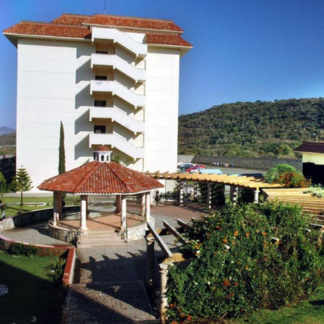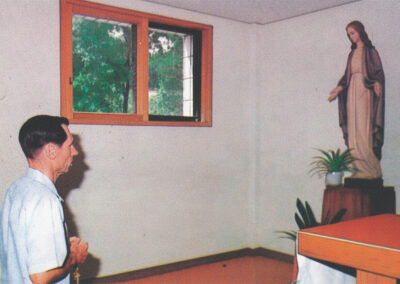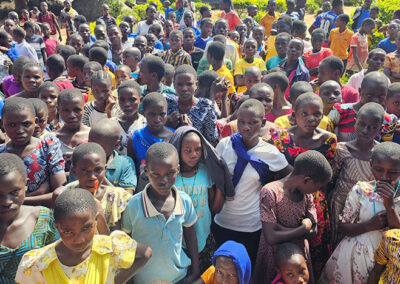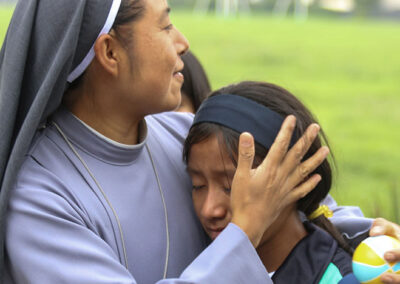It all began with a casual comment by my friend Rodrigo Orozco — also known as Tarantula Man, thanks to the anti-poaching project he leads in western Mexico — when I told him about a hike I was organizing for the following Saturday.
“Sorry, John,” replied Orozco, “I’m going to be tied up for the next 44 Saturdays.”
Of course, I was curious as to what my friend planned to do on nearly a year’s worth of Saturdays.
“Not long ago, I made a little visit to La Villa de los Niños,” he explained, “You might call it the Mexican Boystown. Well, I was most impressed, to say the least and ended up offering to give them my slide-show talk about the Dangerous and Harmless Bugs of Mexico. Well, there just happen to be 2,000 boys over there. Now, in my presentation, the kids always get a chance to see and to touch tarantulas, millipedes, walking sticks, vinegaroons, etc., which means the most individuals that could attend any one sitting would be 45… so, if you do the math, it’ll be about a year before all of them can see my show. Do you want to come along as my assistant sometime?”
Of course, I said yes.
La Villa de los Niños is located 30 kilometers southwest of Guadalajara on Highway 35, just 20 kilometers northwest of Lake Chapala. As we drove through the gate, Rodrigo pointed out several large buildings we could see ahead of us. “Over there is a huge fish farm and that is a bakery and on our right, you can see a body shop. Besides an education, these boys get vocational training in all kinds of skills.”



We stopped at the library. As I helped Rodrigo set up his projector and unpack Tupperware containers full of little wiggling creatures, he turned to me. “You know, I’ve been giving this talk to kids for years. I usually start by asking my audience if they’ve ever heard of arthropods (the family which includes spiders, ticks, mites, etc.) and never once have any kids ever said yes — with the exception of this place. Here several boys immediately raised their hands and they knew exactly what I was talking about. I suspect this Boystown may be the best high school in all of Mexico.”
A few minutes later, around 30 boys walked into the library. They were around 15 years old and they were quiet and orderly. To my surprise, they were not accompanied by an adult. Throughout the conference, which lasted over an hour, the boys were not only well behaved, they were alert, enthusiastic and interested, participating and asking questions the whole time: the kind of audience we presenters dream of.
After the talk, I had a chance to interview the person in charge of the entire operation at the Villa de Los Niños, a small, shy, ever smiling nun from the Philippines named Hermana Nenita.
Hanging on the walls of the room where we talked were photos of other boys and girls towns in Brazil, Guatemala, Korea and the Philippines, all members of one big organization called World Villages for Children. “Who started all of this?” I asked Hermana Nenita.
“An American named Al Schwartz,” she replied, to my surprise. “He was a Catholic priest working in South Korea just after the Korean War and he wanted to help the thousands of homeless children that were wandering the streets at that time.”


I learned that “Father Al” as everyone seems to call him, studied several organizations like Boys Town, Nebraska in the USA, before coming up with a plan of his own. Here in Mexico, both the Villa de los Niños and the site for girls (Villa de las Niñas, located near Mexico City) continue to follow the founder’s system: reaching out to the “poorest of the poor,” wherever they may be found in the country and to look for boys and girls with an aptitude for study.
Their families are then offered a chance to give their child a free six-year education (high school and prep school, including a Bachelor’s Degree). The kids are able to go home only for Christmas and summer vacation, but their relatives can visit them throughout the year.
The entire operation is run by only 14 nuns, members of the Sisters of Mary. Two take care of administration and food, leaving 12 to look after the 2,000 boys. Only twelve — I could hardly believe my ears!
However, the system seems to work amazingly well, perhaps because each group of 33 boys is under the care of an older, more experienced student called a “cuyo” or “elder brother”, a term from the Tagalog language of the Philippines. As far as I could see, when it comes to orderliness and friendliness, it would be hard to beat the people I met at this Boystown.
During their stay at Villa de los Niños, the boys spend a number of years learning one or more of 14 different trades or skills taught to them by experts. These include aquaculture (fish farming), baking, horticulture, mechanics, body shop, electricity, computers, refrigeration and air conditioning, carpentry, English, Tae Kwan Do, silk screening and every aspect of jewelry making, such as lost-wax casting and engraving.
I had the pleasure of touring several workshops on the campus with Sister Magdalena. She took me first to a huge, hothouse-like building which houses the fish farm. There the boys learn to raise tilapia and actually produce 10,000 fish per year, 90 percent of which are eaten by the Niños and the rest sold to the public. As the aquaculture teacher, Sergio Romo pointed out to me, “a cubic meter of water with fish in it produces much more money than a square meter of land ever could,” so this skill is of great value to boys living in areas with streams and lakes.
Professor José Elias Arias teaches refrigeration and air conditioning at Villa de los Niños and pointed out to me that these classes are identical to those he holds in Guadalajara for people aiming to become professionals in the field. “Apart from the fact that every home has a refrigerator and many also have air conditioning,” he commented, “refrigeration is now essential in many industries. I teach the boys to do home repairs, industrial repairs and we’ll soon start a new branch dedicated to automotive AC.”



Because the boys and girls in Mexico’s two Villages learn several of these vocational skills in addition to receiving a first-class education, they graduate in a position to help not only themselves and their families, but their entire village. This, it seems to me, is an excellent example of how education can reduce or even defeat poverty.
Due to the fact that this Boystown has an outstanding reputation for scholarship and now offers a Bachelor’s Degree, a Feria del Empleo (Job Fair) was held here for the first time last year resulting in many job offers for the graduates. Laboratorios Julio — a chain of photography shops in Guadalajara — for example, hired three young men from this school and the owner reported that, after three months, “They were rated the most productive employees in the company.”
This article was first published online in 2012. It has been slightly edited for length and reproduced here with permission from the author, John Pint





